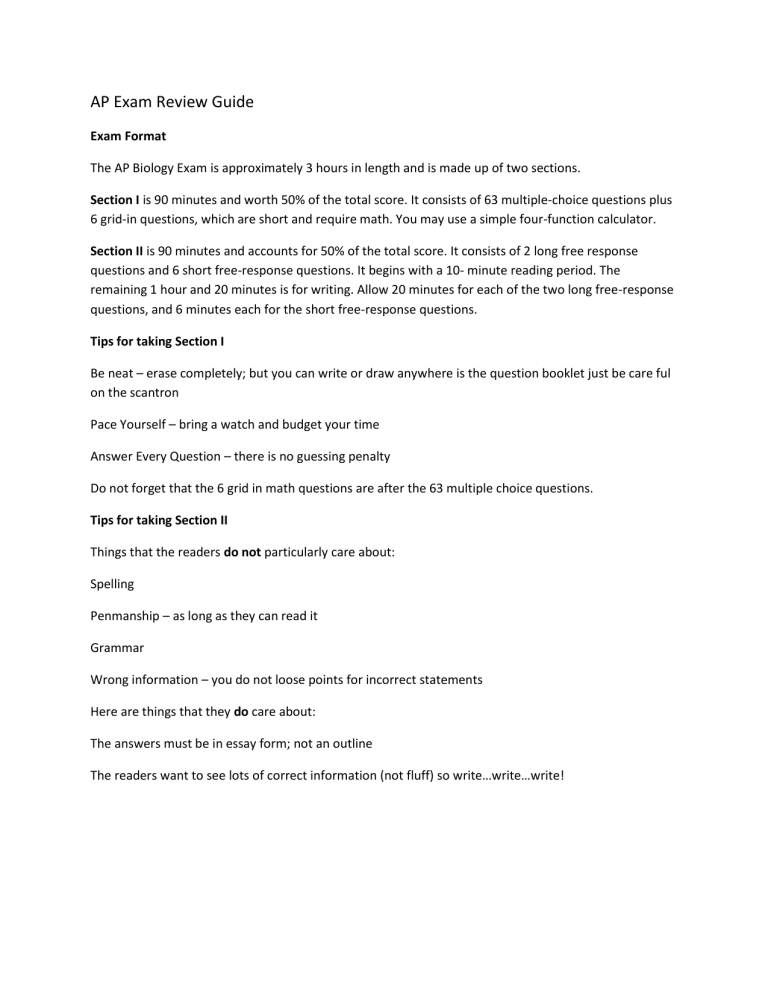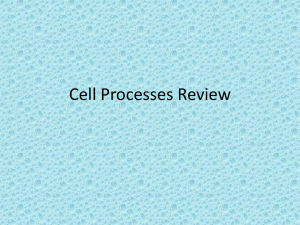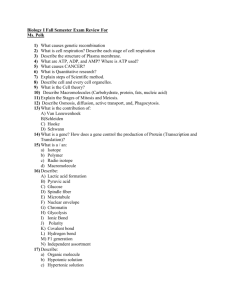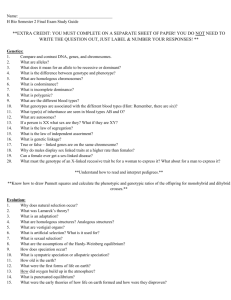Unit two Cells

AP Exam Review Guide
Exam Format
The AP Biology Exam is approximately 3 hours in length and is made up of two sections.
Section I is 90 minutes and worth 50% of the total score. It consists of 63 multiple-choice questions plus
6 grid-in questions, which are short and require math. You may use a simple four-function calculator.
Section II is 90 minutes and accounts for 50% of the total score. It consists of 2 long free response questions and 6 short free-response questions. It begins with a 10- minute reading period. The remaining 1 hour and 20 minutes is for writing. Allow 20 minutes for each of the two long free-response questions, and 6 minutes each for the short free-response questions.
Tips for taking Section I
Be neat – erase completely; but you can write or draw anywhere is the question booklet just be care ful on the scantron
Pace Yourself – bring a watch and budget your time
Answer Every Question – there is no guessing penalty
Do not forget that the 6 grid in math questions are after the 63 multiple choice questions.
Tips for taking Section II
Things that the readers do not particularly care about:
Spelling
Penmanship – as long as they can read it
Grammar
Wrong information – you do not loose points for incorrect statements
Here are things that they do care about:
The answers must be in essay form; not an outline
The readers want to see lots of correct information (not fluff) so write…write…write!
You need to:
Watch the point count! If an essay is divided into two parts each part is worth 5 points. You must get 5 points from each section - not all 10 points from one section.
Bring a watch and budget your time. You have to monitor when to move on to the next essay. There are
8 questions. Question 1 and 2 are long free response that should take 20 minutes each.
Questions 3-8 are short free response questions that should take about 6 minutes to answer.
Organize your thoughts: During the 10 minute reading time brainstorm and write down key words that you will need to include in each topic.
2
1
Do not leave out Basic material – if you use a science word then you need to define it!
Do not contradict yourself – you can’t state that the Calvin cycle occurs in the grana or the chloroplast.
Decide which on you think it is and stick with it!
Include Drawings or graphs – but they must be labeled correctly to get points and the information has to be in paragraph form for it to count. You can’t just do a diagram.
4
3
Do not write formal Literary-style essays; no introductions and conclusions. Just answer the questions.
AP Grade
5
Qualification
Extremely well qualified (could equal 8 college credits)
Well qualified (could get up to 4 college credits)
Qualified (could get introductory credit – 3 credits)
Possibly Qualified
No recommendation
Subject Area Review
Unit One- Biochemistry:
Regulations keep the body in homeostasis.
Provided with an example of a simple negative regulatory system and how an organism uses the mechanism to respond to an environmental change (e.g., temperature regulation in animals, plant responses to water limitation, blood glucose level.)
Negative feedback
Positive feedback
Provided with an example of simple positive feedback loop, making predictions about how the mechanism amplifies activities and processes in organisms based on scientific models (e.g., lactation in mammals, progression of labor in childbirth, ripening of fruit, blood clotting).
Electron configuration determines the behavior of an atom. Valence electrons (outer shell electrons) determine what will bond with what other atom. This determines what type of bond will be used.
Covalent Bond:
Polar Covalent Bond:
Non-Polar Covalent Bond: H – H (H
2
)
Ionic Bond:
Hydrogen Bond:
Van der Waals Interaction:
Properties of Water:
Water has high specific heat
High Heat Vaporization
Water is the Universal Solvent
Water exhibits strong Cohesion and Adhesion
Ice floats because it is less dense than water
Identifying several (more than 4) chemical elements and molecules that function as key building blocks
(e.g., C, N, H
2
0, sugars, lipids, proteins) or are eliminated as wastes.
Using appropriate examples, explain how molecular variation in genes, basic cellular building blocks, and
macromolecules provide a wider range of functions.
Macromolecules are built from the movement of carbon through the environment.
Polymers built from monomers
Functional groups p. 64 & 65
Condensation Reaction: Glucose + fructose
Uses dehydration reactions or hydrolysis
Sucrose + water
Examples of Macromolecules: glucose + fructose
1.
Carbohydrates
Examples:
2.
Lipids
Examples:
3.
Proteins – functions are: growth and repair, signaling from one cell to another, regulation
(hormones like Insulin), Enzymatic activity, Movement: Actin and myosin.
Examples:
Enzymes: Analyze data showing how changes in enzyme structure, substrate concentration, and environmental conditions (pH, temperature, salinity) affect enzymatic activity. Predict the effects when
one of the parameters is further changed.
4.
Nucleic Acids – DNA/RNA
Unit two Cells:
Calculate surface area-to-volume ratios for a variety of cell shapes (spherical, cuboidal, squamous, and columnar) and predict, based on ratios, which cells procures nutrients or eliminates wastes faster.
Spherical:
Cube: V=lwh
Page 99 figure 6.7
Surface area increases while total volume remains constant.
What does this have to do with the size of cells? Everything that the cell needs or has to get rid of has to go through the cell membrane, the amount of which relates to the surface area.
Therefore, the cell's ability to either get substances from the outside or eliminate waste is related to the surface area. Secondly, how much food and other material from the outside and how much waste the cell has to get rid of, is related to the volume.
Therefore, as a cell gets bigger there will come a time when its surface area is insufficient to meet the demands of the cell's volume and the cell stops growing.
There are ways to get around this problem. Bird eggs and frog eggs are much larger than typical cells, but they have a store house of food and also rapidly divide to give rise to multi-celled embryos. In fact this multicellular embryo is a good illustration of another way cells get around the surface area to volume problem: they divide. In the third part of the diagram I've taken the
2mm width "cell" and divided its volume into eight 1mm width cells. Notice that the surface area is much higher, giving more surface for obtaining nutrients, gas exchange, etc.
Describing the basic structure and functions of key biological polymers and cell organelles
(nucleus, Golgi, ER, mitochondria, chloroplast, vacuoles, plasma membrane).
Cell organelles:
Chloroplast
Mitochondria
Theory of endosymbiosis states that the mitochondria and chloroplasts where once free-living prokaryotes that became permanent residence inside larger cells.
Ribosomes
ER: is a system of channels and sacs that can contain rough ER with ribosomes that produce proteins; smooth ER synthesizes lipids and also detoxifies drugs and poisons from the body.
Nucleus
Golgi bodies are flattened membranous sacs that are surrounded by vesicles – they process and
package substances produced in the rough ER. It secretes substances to other parts of the cell.
Lysosomes
Cytoskeleton
Vacuoles
Plasma membrane
Explain how several internal membrane-bound organelles and other structural features (e.g. ER, ribosomes) work together to provide a specific function for the cell (e.g., synthesis of protein for export) and contribute to efficiency (e.g., increasing surface area for reactions, localization of processes).
Transport in cells:
ER – vesicles - Golgi Bodies – vesicles (can become part of a vacuole or lysosome)
Energy in cells:
Photosynthesis: Chloroplast works with the
Cellular Respiration: Mitochondria
Provided with a visual of the fluid mosaic model of the cell membrane, identifying the molecular components and describing how each component is directly related to the selective permeability of the of that membrane (e.g., transport proteins, lipid bilayer).
Provided with electrochemical properties of several different molecules, make predictions about the permeability of the membrane to the molecule(s) and describe several methods of transport
(e.g., diffusion, facilitated diffusion, osmosis, active transport, exocytosis, endocytosis) across the membrane.
Passive transport
Diffusion
Facilitated diffusion
Osmosis
Hypotonic
Hypertonic
Isotonic
Active transport
ATP
Exocytosis
Endocytosis
Unit three: Energy - Photosynthesis/Cellular Respiration
Organisms capture and store free energy for use in biological processes; what mechanisms and structural features allow organism to capture, store, and use free energy (e.g., photosynthesis, chemosynthesis, anaerobic, aerobic respiration)
Energy –
Cellular Respiration is the breakdown of food into energy (ATP) in the __________________.
Three stages of Cellular Respiration or aerobic respiration
1.
2.
3.
To recharge – ATP to ADP is called __________________
Anaerobic respiration compared to aerobic respiration
Photosynthesis converts light energy to the chemical energy of food occurs in the
_____________________.
Two stages:
Light –dependent reactions
Calvin Cycle
Create a visual representation to describe the structure of cell membranes and how membrane structure leads to the establishment of electrochemical gradients and the formation of ATP.
Electrochemical gradient / Chemiosmosis
Alternate forms of photosynthesis
Unit Four- Cell Cycle:
Justify the effects of a change in the cell cycle mitosis and/ or meiosis will have a chromosome structure, gamete viability, genetic diversity, and evolution. Explaining how the steps in the cell cycle allow transmission of heritable information between generations and contribute to genetic diversity.
Draw and label the parts of a Sister Chromatids
Interphase G
1-
S-
G
2-
Draw and label “M” phase
Meiosis
Draw and label Homologous chromosomes
What happens in prophase I that increase genetic variation__________________________
(Recombinant DNA)
Difference between diploid and haploid cells
Difference between Mitosis and Meiosis
AP Bio Review
Unit Five: Genetics
Justify whether a given data set supports Mendelian inheritance. Using appropriate examples, explain at the chromosome, cellular, and offspring level why certain traits do or do not follow Mendel’s model of inheritance.
Give an example of each term below:
Homozygous
Heterozygous
Phenotype
Genotype
Parts of a monohybrid Punnett square: cross a heterozygous yellow pea plant dominant to a recessive green plant
Law of independent assortment
Law of segregation
What is the difference between autosomes and sex chromosomes?
Test crosses:
Alternate ways to do Dihybrid crosses: (cliffs book)
Modes of inheritance:
Dominant /recessive
Autosomal recessive/ X-linked recessive
Codominance
Incomplete dominance
Multiple alleles
Sex-linked
CHI square Practice
A genetics engineer was attempting to cross a tiger and a cheetah. She predicted a phenotypic outcome of the traits she was observing to be in the following ratio 4 stripes only: 3 spots only: 9 both stripes and spots. When the cross was performed and she counted the individuals she found 50 with stripes only, 41 with spots only and 85 with both. According to the Chi-square test, did she get the predicted outcome?
In the garden pea, yellow cotyledon color is dominant to green, and inflated pod shape is dominant to the constricted form. Considering both of these traits jointly in self-fertilized dihybrids, the progeny appeared in the following numbers: They follow the 9:3:3:1 ratio.
193 green, inflated
184 yellow constricted
556 yellow, inflated
61 green, constricted
Do these genes assort independently? Support your answer using Chi-square analysis.
Observed
Expected
556 184 193 61
AP Bio Review
Unit Six
The nucleotide is the monomer that makes up the DNA the polymer; bonded by covalent bond
The backbone in antiparallel
5’ end is the phosphate end and the 3’ end is the sugar end.
Bonded by
Hydrogen Bonds
ACTTGGATCG pairs with______________________________
Replication takes place during ____________________.
Replication
One strand serves as the template for the other strand. It requires enzymes.
New strand that goes first and elongates in a
5 – 3 direction
Grows in a 3 – 5 direction by adding short segments at a time called________
What are the basic steps of replication?
Enzymes needed to complete the process:
Polymerase
Ligase
Helicase
Topoisomerase
Transcription and Translation
Based on the diagram above what are the steps of Transcription
Based on the diagram above what are the steps of Translation
Hardy –Weinberg Practice
B.
C.
D.
E.
1.
If 98 out of 200 individuals in a population express the recessive phenotype, what percent of the population are homozygous dominant?
A.
49%
70%
30%
42%
9%
1.
If 98 out of 200 individuals in a population express the recessive phenotype, what percent of the population are heterozygotes?
A.
B.
49%
70%
C.
D.
30%
42%
9% E.
Brown hair (B) is dominant to blond hair (b). If there are 168 brown hairs in a population of 200:
1.
What is the predicted frequency of heterozygotes in the above problem?
A.
B.
16%
40%
C.
D.
E.
60%
48%
84%
More Hardy-Weinberg Practice: http://www.indiana.edu/~l111/handouts/hardy.htm








